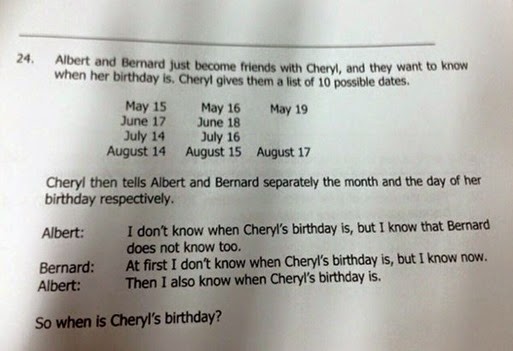Albert was told either: May , June , July , August
Bernard was told either: 15 ,16,17,18,19
| May | 15 | 16 | 19 | ||
| June | 17 | 18 | |||
| July | 14 | 16 | |||
| August | 14 | 15 | 17 |
Albert :
- I Don’t know when charley's B’Day.
- Bernard does not know too.
First we take second argument. If Bernard know the answer It should be June 18 or May 19. Because they are the only dates that does not have ambiguity in months. So Albert knows it is not 18 or 19. Now albert remains with these options.
| May | 15 | 16 | |||
| June | 17 | ||||
| July | 14 | 16 | |||
| August | 14 | 15 | 17 |
Albert saying that I don’t know when charley's B’Day. if albert told month as June would know the answer because only one date left to pick in the June that is June 17. But he Says He don’t know the answer, which means the month told to him was not June.
Bernard:
- First I don’t know the answer
- But Now I Know
First I don’t know the answer means he was not told with 18 or 19. so based on Albert answers now Bernard left with these months and dates.
| May | 15 | 16 | |||
| July | 14 | 16 | |||
| August | 14 | 15 | 17 |
Assume Bernard was told 14, so there are two possible months.
Assume Bernard was told 15, so there are two possible months.
Assume Bernard was told 16, so there are two possible months.
But Bernard says I know the Answer so he should told with 17. Because it is the only date that has one possible answer left.
So Bernard know knew the answer Aug 17. and he told that he knew the answer.
Now albert know to Bernard to know the answer it should be Aug 17. so Albert also know the answer.

Comments